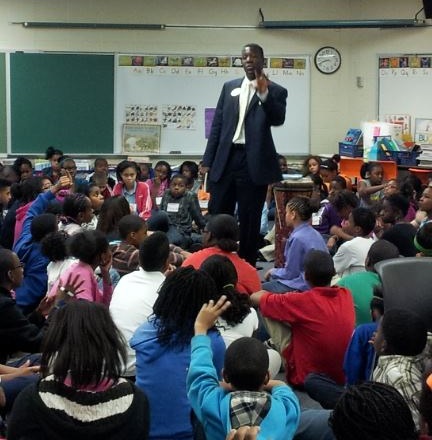
What will be build tomorrow? We know that the care of many children, and more children yet unborn, are in our hands.
What we build tomorrow depends on what we reconstruct today. As an education leader, I know that one of the biggest rooms in our educational house is the room for continuous improvement. A commitment to continuous improvement is essential in education; yet, improvement alone is not enough.
Building a clock is not enough. K-12 education systems must make it the standard to teach students how to program computers and build machines that build clocks and more using 3D printing, AutoCAD, and other software.
 |
| Art McCoy speaks to elementary school students on literacy, life success and leadership. |
Schools can be direct forces of social change. To sever the attainment gaps of today educational institutions must advocate for the redesign of the educational system for social change, student empowerment, and skills and innovation. Together, communities, educators, and industry experts must rebuild this system to help ensure that all citizens receive an education and experiences that properly prepare them for postsecondary education, productive careers, and satisfying lives.
A cradle-to-career approach with a variety of options provides for comprehensive structural supports and workforce pathways for education and business.
With much help and many mentors, this was how I graduated with my bachelor’s degree a year and a half after receiving my high school diploma (with over 40 college credit hours). Shortly after, I was recognized as the youngest certified teacher in Missouri at age 19. So much more is possible for all students if we build structures and pathways today of what we expect to see more of tomorrow.
In learning environments with such cradle-to-career supports, a culture of success thrives. Children can and have overcome obstacles created by poverty, systemic oppression, language barriers, and learning disorders.
Individuals and organizations have specific roles to play. A few of the organizations that I see making a tangible difference:
To make this a greater reality or take it to scale, we must take it to heart, put our heads and hands together.
We must advocate for and support transformative programs and conceptual learning opportunities for millions more students to experience creativity, problem solving, technical skills, adaptability, perseverance and critical thinking. Equipped with these skills, students will embark on a path of success that extends through high school, post-secondary education, careers, well into tomorrow’s competitive knowledge economy.
A version of this article was originally published in the Construction Forum STL Winter of 2014 Journal.

Art McCoy, Ph.D., was Chief Academic Officer and Superintendent-in-Residence at MIND Research Institute. He is also the founder of Severing the Achievement Gap in Education of Students, SAGES, a consulting and professional development organization.
Comment